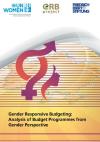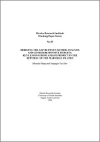FOUND 71
This paper by the Commonwealth Secretariat (1999) provides a rationale for the strategic goals of the Commonwealth Gender Budget Initiative at the national level and highlights the need for integrating a gender perspective in macroeconomic policies and budgets.
This paper attempts to briefly examine the level of readiness/preparedness of Pacific Island countries (PICs) to advance the process of incorporating gender-responsive budget initiatives into national policies and public expenditure management systems.
The main goal of the Albanian Time Use Survey is to develop nationally representative estimates of how people divide their time of various life activities. The main objectives to be achieved through the time use survey were:
The subject of this analysis is the budget process in the Republic of Macedonia (RM), with emphasis on the reforms of budget policies in terms of gender equality and determining entrance points for integration of the gender into the budgeting process.
The purpose of this manual is to provide public officials working on gender budget analysis a simple tool on how to carry it out.
The guide brings together and synthesises several innovative and tested strategies on gender responsive planning & implementation from across India.
Knowing the economic costs of the activities of state institutions is necessary for budgeting addressing the implementation of the legislation against domestic violence.
This paper examines a GRB pilot project undertaken in the small Pacific country of the Republic of the Marshall Islands (RMI).
This publication intended for those who wish to better understand the links between gender equality, public policy formation and development financing.
Budgeting for Equity: Gender Budget Initiatives Within a Framework of Performance Oriented Budgeting
The publication discusses the tools needed to determine how a government budget impacts the different sexes. The publication achieves three objectives. First, the background of gender responsive budgets is described for readers who are not as familiar with the initiative.





